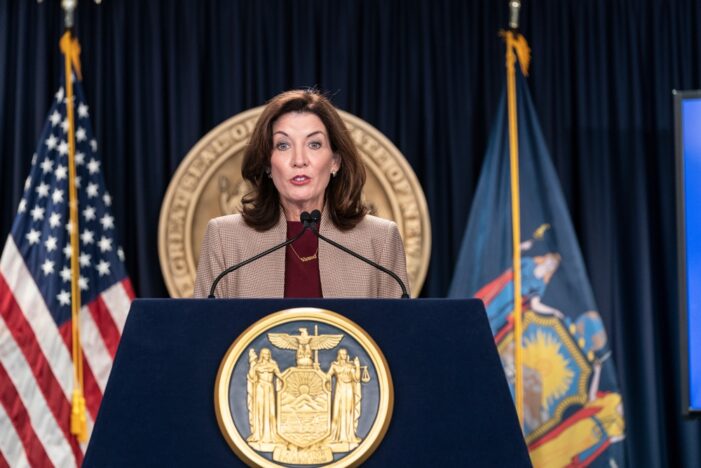Ever since Gov. Kathy Hochul and Mayor Eric Adams put on the table sweeping reforms to accelerate housing construction, Rachel Fee has been meeting with state lawmakers to convince them New York has to do something dramatic to solve its housing crisis.
“Every legislator we meet with starts out with an acknowledgement that we have a housing crisis and that we need housing in every district,” said Fee, the executive director of the New York Housing Conference, a housing advocacy nonprofit.
But Tuesday night, her confidence that the legislature would act on the crisis was dealt a blow when both the state Senate and Assembly rejected virtually every housing proposal from the governor and mayor. Both sides are girding for what will be included in the budget — which is supposed to be adopted by the end of the month.
“There is a disconnect” between what individual representatives told her and what the leadership presented in their budget proposals, Fee admitted. But she remains hopeful.
“The next several weeks is the time for negotiation,” she added. “The governor put out a strong plan and there is room to modify it.”
The legislature’s challenge to the governor goes beyond housing; both houses also rejected Hochul’s measures to modify bail reform, add charter schools and fund the MTA. The legislature also proposed raising income taxes on the wealthy, which the governor opposes. But nowhere is the gap as large as on housing.
Through zoning changes, the governor and mayor want to force communities to accept more housing, following a model pioneered by California and other states. They also are proposing tax breaks to help make new development and restoration of dilapidated older buildings feasible.
The legislature, on the other hand, is proposing a far more limited approach that would offer financial incentives to communities to encourage more housing development. And they would add no new tax relief to promote development.
And the two houses are also pushing bills that would cap rent increases and allow tenants to legally challenge unreasonable rent hikes while requiring landlords to renew tenants’ leases in most instances, seeking to allow evictions only for “good cause.”
Suburban Solution
New York has not built enough new housing to keep up with a growing population, which has led to sky-high prices for homes and rents. The governor and the mayor agree on the solution. Hochul has proposed the state build 800,000 new housing units over the next decade, which includes Adams’ target of 500,000 for the city in the same time period.
The proposal necessarily targets New York City’s suburbs, where new housing gains have lagged the nation’s. Many suburbs that have limited new housing construction mostly to pricey single-family houses have remained home to virtually all white residents.
The governor wants to require localities to increase their housing stock by 3% over three years or lose their ability to reject development proposals. Hochul also proposed that New York suburbs with transit hubs be required to allow density as high as 50 units per acre near those stations. She proposed a fund to help towns with infrastructure needs, and a tax break to encourage affordable units.
Responding to an uproar in the suburbs about the loss of local control, the legislature decided to try a carrot rather than a stick, proposing a $500 million fund to award incentives to communities that meet the target. It is unlikely to work, Fee said.
“This approach has not been successful in other states,” she said. “By focusing on weak incentives that will not motivate local leaders to act, the legislature has endorsed the status quo and enabled the regressive forces working to keep New York unaffordable and segregated.”
The 3% target would also apply to every community district in the city, which the Adams administration has supported. A Furman Center study released last month showed that about half of the districts in the city — including all of Staten Island, southwest Brooklyn, central and northeastern Queens — had not added 3% to their housing stock between 2017 and 2019.
It wasn’t just the governor the legislature ignored. The mayor got the Assembly’s back hand on all his requests and only some help from the Senate.
The Adams administration is asking Albany to change housing law to help spur the conversion of office buildings to residential use. City Hall also asked for a tax break that would help make it feasible for conversions to include affordable housing. The Assembly rejected those ideas. The Senate seems open to the ideas with tweaks, including requirements for affordable units.
Real estate experts say the measures Adams proposed are needed in order to convert office buildings in Midtown into housing, as THE CITY previously reported.
The administration also pushed for a replacement for the expired 421-a tax break — which provided an exemption from property taxes in exchange for the creation of affordable units — and a new version of another tax incentive, called J-51, which encouraged rehabilitation of older apartments.
Not only did the Assembly and the Senate not propose replacement tax breaks — they even ignored a modest proposal that would have extended the deadline for completing building projects under the old 421-a program. The Real Estate Board of New York (REBNY) recently said an extension could result in 32,000 more housing units.
‘Good Cause’ Push
What the legislature did do in its proposal was endorse, for the first time, so-called good cause eviction rules, which would limit rent increases in market-rate apartments, give tenants the power to legally challenge a rent hike, and define the reasons for which a landlord could refuse to renew a lease.
The concept is detested by real estate groups like REBNY, although it has garnered support from pro-housing groups like Open New York, a grassroots “Yes in My Backyard” (YIMBY) organization pushing for proposals like suburban building requirements.
In an echo of the issue over suburban requirements, tenant advocacy groups argue that their “good cause” proposal is based on laws passed in states like California, Oregon, New Jersey and elsewhere. The comparison is controversial.
“Most other states have more carve-outs than the tenant group’s proposal, don’t apply to new buildings for a number of years, and establish much less onerous rent limitations,” said Sherwin Belkin, a real estate lawyer whose firm has been challenging local good cause laws around the state.
Most states with such laws have no rent caps, instead prohibiting extreme rent increases. Two states with rent caps — California and Oregon — allow annual double-digit increases. The New York proposal allows for rent increases of up to 1.5 times the consumer price index, which would have limited hikes to less than 5% annually in recent years — although, with high inflation this year, it likely would be around 9%.
It isn’t unusual for the governor and the legislature to be at odds in mid-March as they begin intense, behind-the-scenes horse trading that results in a budget that includes most of the other policies each side is attempting to advance. But the stark differences on housing took advocates by surprise this week. By getting behind good cause, the legislature may have been seeking to split the real estate industry and the housing advocacy groups that have supported the idea like Open New York.
The optimists — including the mayor — see room for compromise. “It’s part of the process and so we’re looking forward to the next level of this. It is not done until it is done,” Adams said on Wednesday.
Good cause can be revised, say its supporters. “We are expecting to negotiate around the rent increase limit,” said Cea Weaver, coordinator of the good cause campaign for Housing Justice for All, a statewide tenant advocacy group.
And in an interview with THE CITY last week, state housing commissioner RuthAnne Visnauskas said the Hochul administration was willing to negotiate around transit hub density and other provisions.
How much the governor will be able to pass remains to be seen.
“There was a lot in this proposal for the legislature to consider and to understand impact in every legislator’s district,” noted Fee. “We’d like to pass the strongest version possible this year, but understand compromise will be necessary to even advance parts of it. A compromise will still be a win.”
But others are already looking beyond this year.
Vicki Been, the deputy mayor for housing under former Mayor Bill de Blasio who is back at her longtime post at the Furman Center, says one way to keep the issue in the spotlight is to require all local governments to report on their housing production — and how it compares to the 3% growth target.
“The natural inclination of any elected official will be to stay away from this topic if these proposals fail this year,” Been said.
Open New York vows that will not happen.
“We are going to fight this year, next year whatever it takes to happen,” said Andrew Fine, the group’s policy director.

